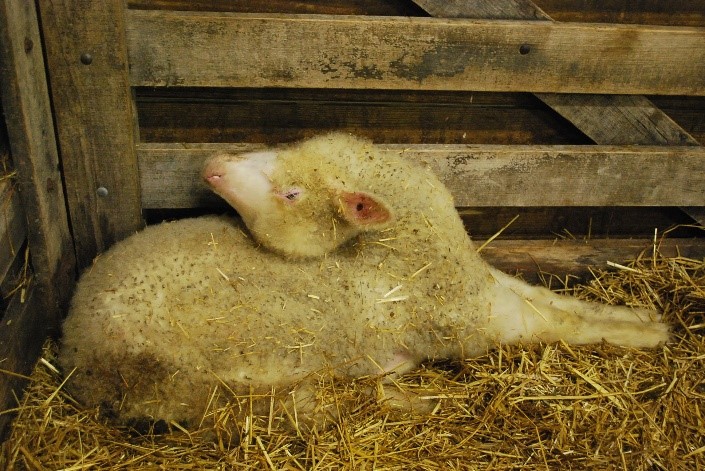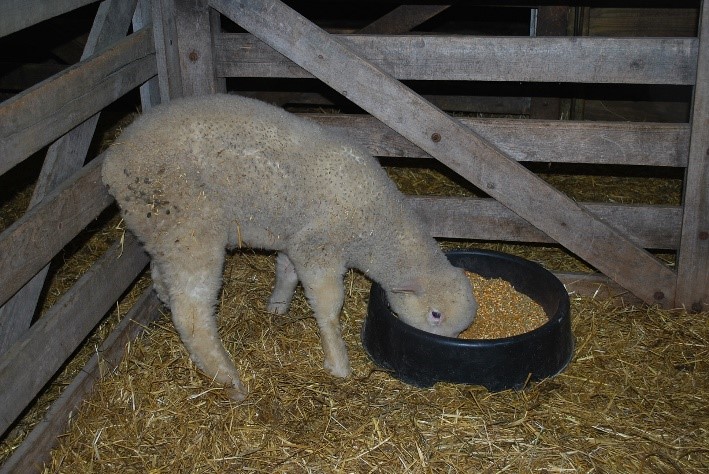Polioencephalomalacia
Understanding How to Prevent and Treat Polioencephalomalacia (PEM) in Sheep and Goats.
by Richard Ehrhardt, Small Ruminant Extension Specialist, Michigan State University
Polioencephalomalacia (PEM) is also known as cerebrocortical necrosis (CCN) and is a relatively common nutritional disorder in sheep and goats. A common name for this disease in sheep and goats is “polio”; however, it has absolutely no relationship with the infectious viral disease found in humans (poliomyelitis). Cases of PEM can be successfully treated if detected early in the disease course, making recognition of early symptoms a critical issue for sheep and goat producers.
Causes of PEM
The most common cause of PEM is thiamine deficiency. Thiamine is a B vitamin (vitamin B1) that plays a critical role in all cells, acting as a cofactor for several key enzymes involved in glucose metabolism. Thiamine is especially important for proper brain function as the brain relies on glucose as its major source of energy. Since the brain controls nearly all bodily functions, adequate thiamine levels in the brain are of critical importance for normal health and well-being. Thiamine is not produced in animal cells but is produced by rumen microbes, which provide the major source of thiamine to adult sheep and goats. Milk-fed lambs and kids must get thiamine preformed from their diet to meet requirements. But then as they transition to becoming ruminants, they rely on their rumen microbes to synthesize thiamine as their thiamine source. The incidence of polio tends to be higher in lambs and kids during the period when they transition to becoming full ruminants.
Inadequate thiamine levels are not the only cause of PEM in sheep and goats, but it is responsible for the vast majority of cases observed. Another cause of PEM documented much better in cattle is excessive sulfur intake from sources including water, feed ingredients and forage. Elevated dietary sources of sulfur in sheep and goat diets include by-product feeds of the ethanol industry such as wet or dry distiller’s grains with solubles. The sulfur content of these feeds may vary according to the processing plant or even the batch, as much of the additional sulfur content in these by products results from addition of acidifying agents such as sulfuric acid during the production process. The usage of these sulfur-rich products varies across ethanol plants, so blanket statements regarding ethanol by-product feeds as being high in sulfur cannot be made. Sheep and goats also consume cruciferous or brassica forages such as turnips, rape, mustard and oil seed meals; products which can be high in sulfur as well.
PEM can also be triggered by amprolium therapy for coccidiosis. Amprolium effectively competes with thiamine for uptake into the brain which therefore can induce PEM. Therefore, animals on amprolium therapy should be watched carefully for polio. Induction of PEM with amprolium in uncommon but not rare.
Symptoms of PEM
Thiamine deficiency and/or high sulfur levels within the brain cause destruction of neurons and swelling of the brain which can be diagnosed by histological examination of brain tissue. Therefore, PEM symptoms are manifest as neurological, with early symptoms being partial to complete blindness with the head held erect. This may also be associated with unilateral (uneven) ear droop and/or unusual/exaggerated gait. It is common for the pupils to be dilated and for the eyes to tear. PEM affects animals of all ages but is most common in young lambs and kids transitioning from a milk to solid diet, and especially so in those fed a high-grain diet. PEM is also found in adult small ruminants of either sex at any age but more commonly associated with changes in diet (change in the plane of nutrition, pasture type, pasture to forage feeding, forage feeding to grain addition, etc.). PEM symptoms are similar regardless of age. Early blindness symptoms lead within hours to a day to loss of body control, inability to stand, and seizures. In more advances states, animals commonly arch their heads back as far as possible. PEM symptoms may present itself similarly to listeriosis and even ketosis. However, thiamine therapy is relatively benign, so it is best to treat with thiamine as a precaution.
Treatment of PEM
Many cases of PEM response to prompt administration of thiamine (minimum dose of 10 mg/kg bodyweight). Effective but slightly more risky therapy would be to inject the first dose slowly intravenously (IV) followed by another dose provided intramuscularly (IM). Animals occasionally respond rapidly to the initial dose, although slow recovery to standing may take up to 5 days with full recovery evident after 2-3 weeks. The recommended dosage should be given twice per day for 2 days followed by once daily injection for 5 days. Vitamin B complex formulations can be purchased containing thiamine, but it is highly recommended that producers have a bottle of concentrated thiamine on hand (250 to 500 mg/mL) at all times. Concentrated formulations of thiamine are a prescription product, so be sure to work with your veterinarian on any PEM treatment program. Additional therapeutic value may be found by administration of anti-inflammatory drugs to reduce brain inflammation along with thiamine administration. Consult your veterinarian for information on the safe and effective use of anti-inflammatory drugs.
Animals with PEM may take several days to stand on their own, so it is important isolate all cases and provide supportive care to encourage water and feed consumption (provide both grain and forage free choice to encourage standing and feed consumption). Animals that have been down for a few days may require a little assistance and retraining to get them standing. In cases that are more advanced, thiamine therapy may not be able to overcome brain trauma that has occurred and euthanasia may be indicated.
Prevention of PEM
Most cases of PEM are isolated and sporadic in nature and are associated with changes in feed of some sort. Therefore, it is difficult to develop an effective prevention program for these cases, although making gradual dietary transitions will certainly reduce the incidence of PEM along with many other health concerns. In circumstances when PEM becomes common such as in feedlot lambs that are in transition to a high or exclusively grain diet, the risk may be reduced by providing adequate dietary fiber. Lamb/kid finishing diets that are low in fiber may need to be adjusted to raise dietary neutral detergent fiber (NDF) above 15%. Another consideration in situations of high PEM incidence would be to make sure that part or all this NDF is provided in a physical form that encourages rumination, such as forage with a chop length greater than 3 inches. Addition of feed grade thiamine can also be made to the diet, but this therapy can be expensive and its efficacy has not been thoroughly evaluated in growing lambs or kids.

This image shows a lamb with advanced PEM symptoms: head arched and unable to stand.

This is the same lamb 4 days after a daily thiamine therapy regime. The lamb recovered completely in 2 weeks and is now a productive, 4-year-old ewe.
Summary
PEM is a common nutritional disorder in sheep and goats that commonly leads to mortality without intervention. As with many disorders and disease conditions, early detection is key for successful treatment. Producers should work with their DVM to specify a treatment plan and to be sure to have a bottle of concentrated thiamine on hand at all times. Most PEM cases are isolated and sporadic in nature; however, a higher incidence may occur in lamb/kids on finishing diets. In these cases, the first action should be to increase dietary fiber as a preventative measure.



 Print
Print Email
Email